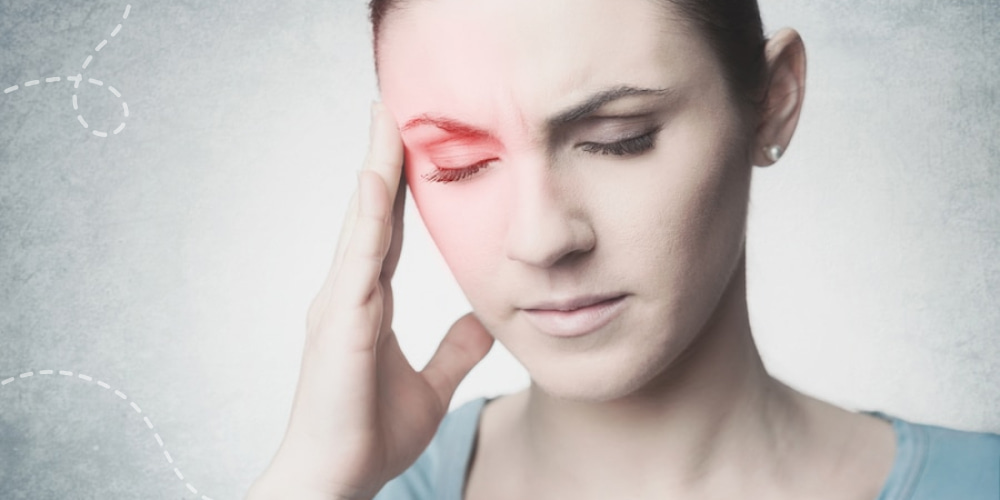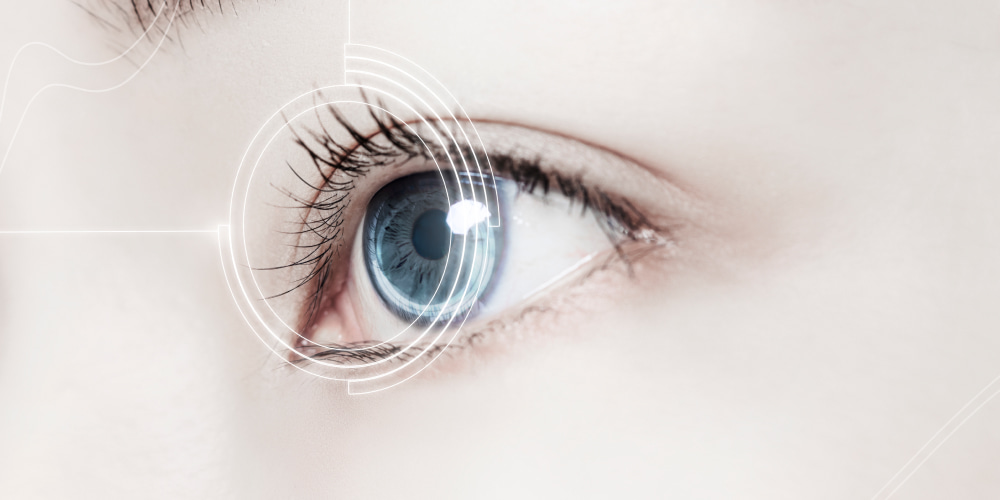Retinal migraine is characterized by the presence of an aura with visual disturbances, which appears before the onset of headache pain. Also, visual problems can appear in the patient without a subsequent attack of headache. In this case, they can persist for more than 2 weeks. Treatment of the disease is symptomatic. To exclude the presence of serious diseases, the patient needs a complete examination. Therapy is necessary not only at the time of a retinal migraine attack but also after it to prolong the period of normal well-being. The second name of the pathology is ciliated scotoma.
With ophthalmic migraines, there are no organic changes in the visual system. Signs of a visual aura appear only due to a temporary deterioration in blood circulation in the tissues of the eyes and the development of a hypoxic attack. For the first time, such a disease as an ocular migraine was described in the 19th century. Most patients are faced with a violation at a young age due to the lability of the autonomic nervous system. More often, pathology occurs in women who work with heavy eye strain. Also, doctors found that pathology can be hereditary. If both parents suffer from migraines, the child is 90% more likely to get it. The mechanism of inheritance of the disorder has not yet been established. Spontaneous remission, which can last for a significant period, occurs in some patients. So in a lonestarneurology, you can find detailed information about retinal migraine.
Retinal migraine symptoms
According to its clinical manifestations, ciliated scotoma is difficult to confuse with other ophthalmic diseases. With retinal form, provoked by abnormal relaxation of the posterior cerebral artery, the patient is worried about:
- defects arising in the field of view – bright flashes, flickering, dark spots, and streaks that can merge;
- the gradual total decrease in visual acuity;
- the appearance of phosphenes (visual images) in the “blind” areas of the visual field and along its periphery;
- increased sensitivity to light, sounds, touch. They increase the pain, so the patient seeks solitude and silence.
An ocular migraine can be complicated by a headache localized in the frontal lobe and the bridge of the nose, passing to the eye sockets. It pulsates, intensifies, and weakens, as in labor pains, inevitably reaching a peak. At the peak of the attack, pain is complicated by nausea, vomiting, and a feeling of fullness in the head.
The average duration of an atrial fibrillation attack is from 30 to 300 minutes. A mild degree of anomaly occurs within 10-20 minutes and sometimes is not accompanied by headaches. After the end of the attack, it takes up to 1 hour to fully restore vision.
If atrial fibrillation is provoked by compression of 3 pairs of cranial nerves, the patient experiences:
- transient drooping of the upper eyelid;
- dilation of the pupil in one eye while maintaining the size in the other;
- dilation of the pupil against the background of paralysis of the muscles that regulate its diameter;
- divergent strabismus due to paralysis of the oculomotor muscles in one eye.
Among the visual impairments in a retinal migraine of this form, there is a double image where one eye perceives the picture correctly, and the other transmits an image inverted horizontally or vertically. This picture is typical for children and adolescents entering puberty.
An ocular migraine with compression of the cranial nerves has a specific “Alice’s syndrome” consisting of the appearance of visual hallucinations visible with lateral vision.
Symptoms with ophthalmoplegic ciliated scotoma persist longer than with retinal scotoma – up to 2 weeks. All this time, anomalies can be accompanied by headaches but often proceed without them.
Causes of retinal migraine
The basis of retinal migraine is neurological dysfunction, leading to a disruption in the work of the visual analyzer. This condition develops due to a decrease in the tone of the posterior cerebral artery. As a result, transient retinal ischemia and oxygen starvation of the brain occurs. The disease is neurological and is not associated with pathologies that lead to changes in the tissues of the brain or eyes.
The appearance of ocular migraine attacks is associated with the effect of provoking factors on the body, the main of which are considered by doctors to be the following:
- chronic lack of sleep – for an adult, a night’s sleep lasting 8 hours is necessary. Reducing it even by an hour, if this continues for a long time, leads to frequent attacks;
- a sharp change in the weather;
- rapid climate change, when conditions in a new place are seriously different from those that were previously;
- severe stress;
- emotional stress;
- severe mental overload;
- sharp hormonal surges;
- exposure to flickering light;
- inhalation of tobacco smoke;
- a sharp emotional outburst;
- exposure to a pungent odor or heavy and sweet;
- severe physical fatigue;
- eating a lot of products containing caffeine;
- taking some medicines.
Quite often, the disease debuts in persons aged 14-16 years, when there is a rapid change in the circulatory system, hormonal changes, and rapid growth is observed. Also, during this period, any nervous stress is much worse postponed. Retinal migraine symptoms gradually diminish and disappear completely by old age.
Retinal migraine during pregnancy
During pregnancy
Retinal migraine occurs during pregnancy, mainly in the first trimester. If seizures develop late in gestation, this is usually the classic form of the disease. Most often, migraines of the eye occur due to disturbances in sleep and rest, as well as emotional instability.
- Self-treatment of the disease is strictly prohibited.
- To reduce the intensity of attacks and their frequency, strict adherence to the daily regimen is required, which takes into account all the features of the condition of the pregnant woman.
- You will also need to reduce physical activity and avoid stressful situations as much as possible.
- Visual disturbances can lead to a loss of orientation in space; therefore, a woman must sit or lie down at the first signs of the onset of an attack.
- The earlier a pregnant woman seeks medical help when an ocular migraine appears, the higher the likelihood that pain attacks will not cause disorders in the child’s development. Also, the implementation of the specialist’s prescriptions will make the period of carrying the baby more comfortable and reduce the likelihood that headaches will pursue throughout pregnancy. If treatment is not carried out at all, then there is a high probability that even after childbirth, the problem will persist.
Retinal migraine diagnosis
To determine the disease and diagnose ocular sick headaches, you must contact not only a neurologist but also an ophthalmologist. Retinal migraine symptoms are similar to some serious pathologies. In addition to collecting anamnesis, an examination of various parts of the eyes and an assessment of the state of the pupils will be required. To exclude diseases of the brain, to which the disorder is quite often similar, instrumental techniques are used to visualize the brain’s structures. Most often, for this purpose, magnetic resonance imaging is indicated.
When contacting an ophthalmologist, it is important to accurately characterize the visual changes that occur at the time of the attack. To exclude the presence of eye pathologies, the following studies are carried out:
- external examination of the eyes, which makes it possible to exclude the presence of inflammation and injury;
- study of the reaction of the pupils to light and other irritation;
- assessment of the eyeballs’ mobility;
- assessment of the eyeballs’ volume;
- determination of the boundaries of the field of view;
- ophthalmoscopy;
- ultrasound of the eye vessels;
- general eye examination.
After pathologies of the visual system are excluded, an examination is carried out to identify structural changes in the brain. The patient is given a referral to carry out diagnostic procedures, which will be:
- magnetic resonance imaging or computed tomography;
- x-ray of the head;
- electroencephalography.
Based on the results of the examinations, retinal migraine symptoms, and anamnesis, the doctor diagnoses and prescribes the necessary treatment.
Treatment and prevention of retinal migraine
Treatment
Atrial scotoma is not one of the diseases that can be permanently cured. The only way to cope with the disease is to reduce the risk of exacerbation through lifestyle adjustments and regular medication. The goal of treatment is to prevent status sick headache – a particularly severe and prolonged ocular sick headache attack, requiring urgent hospitalization of the patient and intensive care.
In the acute period of atrial fibrillation, patients get prescribed remedies to relieve retinal migraine symptoms:
- analgesics and NSAIDs (paracetamol, ibuprofen) in tablets – for mild attacks;
- analgesics and NSAIDs in injections – for moderate seizures;
- combined analgesics – with an intense headache.
When an aura appears in the first 2 hours, aspirin injections are recommended. The drug helps to improve blood supply and does not allow ciliated scotoma to grow stronger and reach its peak. Regardless of the degree to which the ocular sick headache manifests itself, the patient needs rest. Limit contact with bright lights, loud sounds, and touch.
Between attacks, ciliary scotoma is treated in situations where exacerbations occur more often than 2 times a month. Patients have prescribed drugs for the prevention of vascular insufficiency and neurological disorders:
- nootropics – piracetam, pantogam, pantocalcin;
- muscle relaxants – tolperisone and its analogues;
- antidepressants – fluoxetine.
With the onset of sick headache status – a particularly acute attack of ocular migraine – patients are hospitalized. They are assigned:
- glucocorticosteroids to reduce swelling of brain tissue;
- dehydrating agents to reduce tissue pressure on nerves and blood vessels, which result in the most severe ciliated scotoma;
- antipsychotics to relax the nervous system, eliminate severe headaches, seizures, and vomiting;
- combined non-narcotic analgesics for an intraosseous and periosteal blockade.
Therapy continues until the retinal migraine symptoms are permanently eliminated. Once the condition has stabilized, the ocular sick headache is treated as usual.
Prevention of ocular sick headache
It is necessary to treat not the organs of vision but chronic diseases to avoid deterioration of the condition. In most cases, sick headaches appear due to vascular pathologies, nervous system, and diabetes mellitus.
For the prevention of ocular migraine, it is important to:
- have an active lifestyle;
- get enough sleep;
- establish a balanced diet;
- follow the daily routine;
- try not to overwork;
- avoid stress;
- quit smoking and do not abuse alcohol;
- be more often in the forest and outside the city.
Doctors advise physical education, gymnastic exercises, and swimming. Yoga and Pilates can be a good prevention of ocular migraines. But remember that training should be fun, not exhausting the body; otherwise, excessive exercise can lead to the opposite effect. Anything that helps strengthen the body and improve the nervous system will help reduce the likelihood of visual impairment.
Prognosis of retinal migraine
The prognosis for patients with visual migraines is relatively favorable.
- Despite the incurability of the disease, it can be quite effectively corrected with the help of drugs.
- With the right treatment, it is possible to completely normalize the patient’s condition and provide them with the opportunity to live a full life.
- If the patient does not receive therapy, then the prognosis becomes unfavorable and sometimes bad if ocular migraine attacks begin to occur constantly, due to which, the patient is not able to continue a normal life, losing their ability to work.
- The appearance of complications that develop with frequent intense and prolonged attacks, which the patient does not relieve with the help of drugs, also significantly worsens the condition.
Timely examination and treatment prescribed by doctors are mandatory prevention of the disease. Regular visits to specialists will help alleviate or prevent ocular migraine attacks.
Bottom Line
You don’t have to put up with a headache. If you feel that a headache attack is starting to gain momentum, immediately take the drugs that your doctors have prescribed for you to stop the attack.
If migraine attacks occur several times a month and reduce your performance, you should contact a neurologist to select preventive therapy. Lone Star Neurology has excellent neurology specialists who will definitely be able to find the right approach for you, conduct a comprehensive diagnosis and choose the right treatment! Stay healthy with Lone Star Neurology.
We provide our services in different cities in Texas, including Dallas, McKinney, Richardson, and others.
FAQs
- What kind of disease can cause visual disturbances, which appear before the onset of headache pain?
Retinal migraine is characterized by the presence of an aura with visual disturbances, which appears before the onset of headache pain. Also, visual problems can appear in the patient without a subsequent attack of headache.
- How does ocular migraine manifest?
An ocular migraine is characterized by the presence of an aura with visual disturbances, which appears before the onset of pain. Also, visual problems can appear in the patient without a subsequent attack of headache. In this case, they can persist for more than 2 weeks. Treatment of the disease is symptomatic.
- What is a twinkle in the eyes?
Sometimes, standing up abruptly, you can seem to lose control of your vision: your head is dizzy, and your eyes dazzle so that you cannot see anything even in front of you. This is a fairly common phenomenon that is also called noise and flicker.
- How to distinguish a migraine from a headache?
With tension headaches: the pain is most often felt from all sides, presses like a hoop, but does not pulsate. With migraine: usually, the head hurts on one side, the pain is throbbing, there is nausea or vomiting, there is a fear of light and noise (you want to be in a quiet dark room).
- Why does vision deteriorate in one eye?
Also, vision may fall in one eye due to strabismus. The muscles in one eye work worse, as a result of which the vision on it decreases. Usually, it is typical for children and it is easier to get rid of it in childhood. The next reason is amblyopia, in which one eye practically does not participate in the visual process.
- Why is there a kaleidoscope in the eyes?
The appearance of iridescent halos in the eyes is based on a change in the refractive power of the cornea, which contributes to a change in the angle of focusing of light rays on the retina. Usually, with prolonged systematic manifestation, this pathology indicates serious violations in the human body.
- Why do your eyes hurt from the inside?
The most common causes of acute pain in one eye are eye trauma with damage to the cornea, an acute attack of glaucoma, iridocyclitis, phlegmon of the orbit, neuralgic syndromes, headaches, and temporal arteritis.
- What is the genesis of visual disorders associated with?
The genesis of visual disturbances in migraine is associated with spasms of the central retinal artery. Changes in the vessels of the fundus reflect changes in the vessels of the brain during migraine attacks; after the end of the attack, they disappear. Pathogenetically, migraine paroxysm includes a vascular component: alternation of spasm and dilatation of a certain vascular site.














Please, leave your review
1 Comment
R. Simons
04/01/2024
Very good, concise information. Thank you.
Write a comment: